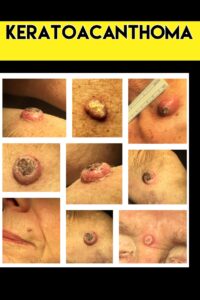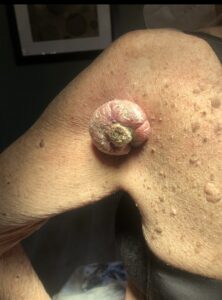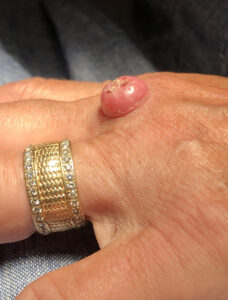 Keratoacanthoma (KA) is a type of skin tumor that typically emerges in skin that has been damaged by the sun. Over the course of a few months, the lesion may develop and grow before eventually shrinking and vanishing completely. It is important to note that KA is a variant of non-melanoma skin cancer and can bear resemblance to a more severe skin condition known as squamous cell carcinoma (SCC). Common symptoms of KA include a raised, dome-shaped lesion with a central depression that can appear on various parts of the body such as the face, neck, ears, arms, hands, or legs.
Keratoacanthoma (KA) is a type of skin tumor that typically emerges in skin that has been damaged by the sun. Over the course of a few months, the lesion may develop and grow before eventually shrinking and vanishing completely. It is important to note that KA is a variant of non-melanoma skin cancer and can bear resemblance to a more severe skin condition known as squamous cell carcinoma (SCC). Common symptoms of KA include a raised, dome-shaped lesion with a central depression that can appear on various parts of the body such as the face, neck, ears, arms, hands, or legs.
In most instances, KA tends to resolve on its own, although this process can take several months. The appropriate treatment options for keratoacanthoma depend on factors such as the location and size of the lesion, as well as the patient’s medical history. The most frequently employed treatment method involves minor surgery to remove the tumor. Additionally, other treatment approaches include cryosurgery, which involves freezing the lesion, curettage, which entails scraping or burning off the growth, and Mohs micrographic surgery, a procedure used to remove lesions from sensitive areas like the ears, nose, hands, and lips.


